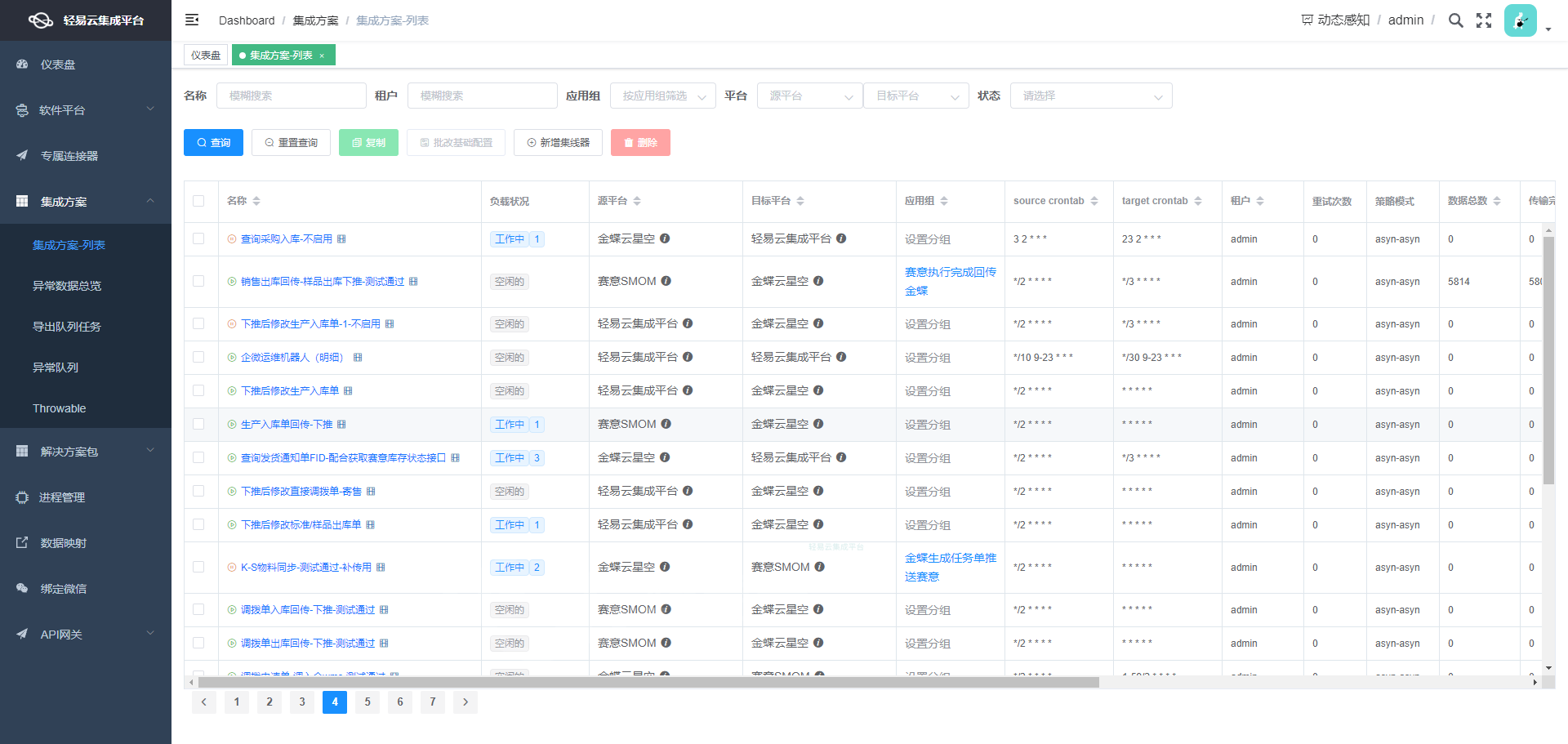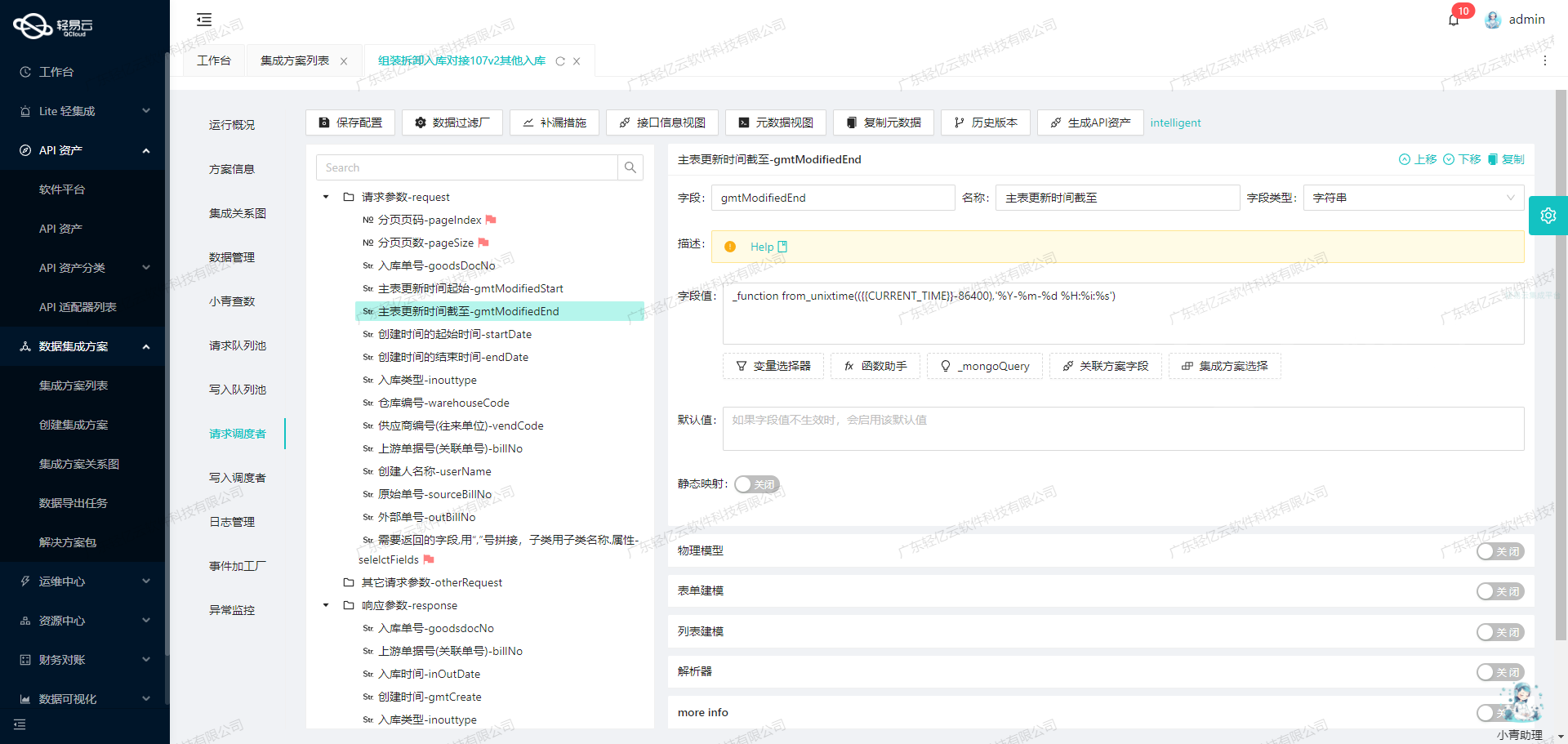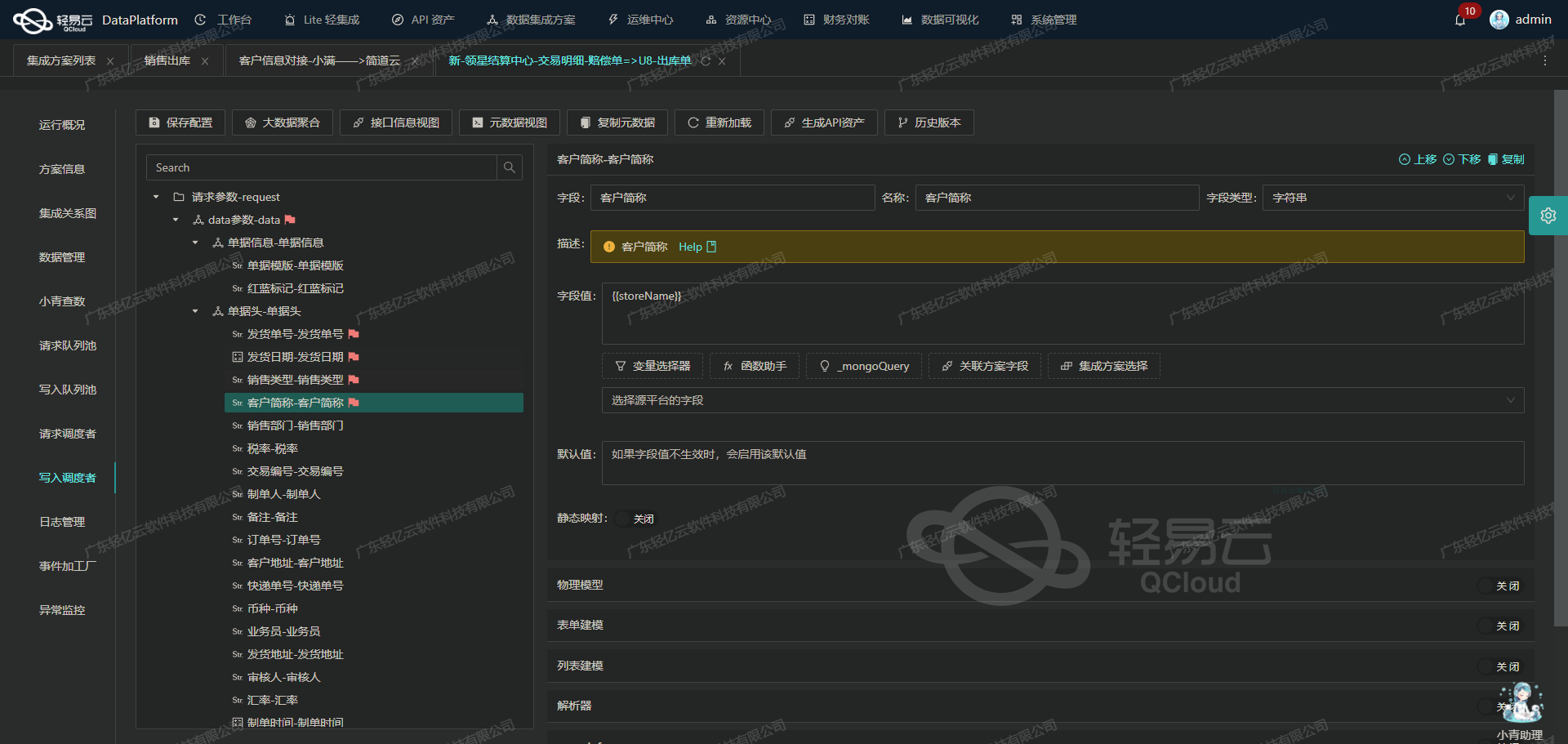畅捷通T+存货分类数据集成至轻易云的实战案例
在系统对接与数据集成任务中,实现畅捷通T+系统的数据流入到轻易云平台是一个常见且具有挑战性的需求。本文将详细解析如何利用API接口,完成“查询畅捷通存货分类”这一具体集成场景。
为了确保从畅捷通T+获取的存货分类数据完整无误,我们首先调用其提供的 /tplus/api/v2/inventoryClass/Query API接口。这一步不仅需要处理分页和限流问题,确保每次请求都得到规范处理,还要抓取全量数据后批量写入到轻易云平台。
页面限流策略是实现可靠抓取的重要一环,通过合理设置分页参数,可以有效地减少请求失败。同时,针对可能出现的数据格式差异及异常情况,我们使用了手动配置映射机制以及错误重试功能,以保证数据的一致性和稳定性。
此外,在实际操作中,及时监控与日志记录也是必不可少的一部分。通过实时监控整个数据处理过程,不仅有助于快速发现并解决潜在问题,更能优化执行效率。在此基础上,对于大批量数据如何快速写入轻易云平台,则可以利用其高效的数据导入功能来应对海量信息交换的需求。
以下内容将逐步介绍具体实施步骤,包括API调用细节、异常处理措施,以及定时任务调度等关键技术点。通过这一系列实践探讨,将帮助您更深入理解和掌握跨系统集成中的重要环节,为类似项目提供参考和借鉴。

调用畅捷通T+接口获取并加工数据的技术案例
在数据集成过程中,调用源系统接口是至关重要的一步。本文将详细探讨如何通过轻易云数据集成平台调用畅捷通T+接口 /tplus/api/v2/inventoryClass/Query 获取存货分类数据,并进行初步加工处理。
接口调用配置
首先,我们需要配置元数据以便正确调用畅捷通T+接口。以下是关键的元数据配置:
{
"api": "/tplus/api/v2/inventoryClass/Query",
"method": "POST",
"number": "code",
"id": "id",
"idCheck": true,
"autoFillResponse": true,
"request": [
{
"label": "指定返回字段",
"field": "SelectFields",
"type": "string",
"value": "id,code,name,parent.id,parent.code,parent.name,isendnode"
}
],
"otherRequest": [
{
"field": "dataKey",
"label": "dataKey",
"type": "array",
"value": ["param"]
}
],
"condition_bk": [
[
{
"field": "parent_name",
"logic": "isnull",
"value": ""
}
]
]
}请求参数设置
在请求参数中,我们指定了需要返回的字段,包括 id, code, name, parent.id, parent.code, parent.name 和 isendnode。这些字段将帮助我们构建完整的存货分类层次结构。
{
"SelectFields": ["id", "code", "name", "parent.id", "parent.code", "parent.name", "isendnode"]
}此外,我们还设置了一个条件,确保只查询没有父节点名称的记录,即顶级分类。
{
"_condition_bk_0_0_field_0_logic_0_value_0_0_0_0_parent_name_isnull_0_value_0_"
}数据请求与清洗
在发起POST请求后,系统将返回包含指定字段的数据。此时,我们需要对返回的数据进行初步清洗和处理。例如,检查每条记录是否符合业务逻辑要求,并过滤掉不必要的数据。
import requests
import json
url = 'https://api.yourdomain.com/tplus/api/v2/inventoryClass/Query'
headers = {'Content-Type': 'application/json'}
payload = {
'SelectFields': 'id,code,name,parent.id,parent.code,parent.name,isendnode',
'dataKey': ['param']
}
response = requests.post(url, headers=headers, data=json.dumps(payload))
data = response.json()
# 数据清洗示例
cleaned_data = []
for record in data['result']:
if record['isendnode'] == True:
cleaned_data.append(record)数据转换与写入
在完成数据清洗后,可以根据业务需求对数据进行转换。例如,将父子节点信息转换为树形结构,或者将特定字段值进行格式化处理。最后,将处理后的数据写入目标系统或数据库。
# 数据转换示例:构建树形结构
def build_tree(data):
tree = {}
for item in data:
tree[item['id']] = item
item['children'] = []
for item in data:
parent_id = item.get('parent.id')
if parent_id and parent_id in tree:
tree[parent_id]['children'].append(item)
return [item for item in tree.values() if not item.get('parent.id')]
tree_data = build_tree(cleaned_data)
# 写入目标系统(示例)
def write_to_target_system(data):
# 假设目标系统有一个API可以接收树形结构的数据
target_url = 'https://api.targetsystem.com/write'
response = requests.post(target_url, headers=headers, data=json.dumps(data))
return response.status_code
status_code = write_to_target_system(tree_data)
if status_code == 200:
print("Data successfully written to the target system.")
else:
print("Failed to write data to the target system.")通过以上步骤,我们成功地从畅捷通T+系统中获取了存货分类数据,并进行了清洗、转换和写入。这一过程展示了轻易云数据集成平台在实现异构系统间无缝对接方面的强大能力。

数据请求与清洗:畅捷通存货分类数据的ETL转换
在数据集成过程中,ETL(Extract, Transform, Load)是关键的一环。本文将详细探讨如何将畅捷通存货分类数据进行ETL转换,以便写入目标平台——轻易云集成平台API接口所能接收的格式。
数据提取(Extract)
首先,我们需要从畅捷通系统中提取存货分类数据。这一步通常涉及调用畅捷通的API接口,通过HTTP请求获取原始数据。假设我们已经成功获取到以下JSON格式的数据:
{
"inventoryCategories": [
{
"id": "1001",
"name": "电子产品",
"parentId": null
},
{
"id": "1002",
"name": "家用电器",
"parentId": null
},
{
"id": "1003",
"name": "手机",
"parentId": "1001"
}
]
}数据转换(Transform)
接下来,我们需要将上述数据转换为轻易云集成平台API接口所能接受的格式。根据元数据配置,目标平台的API接口要求如下:
{
"api":"写入空操作",
"effect":"EXECUTE",
"method":"POST",
"idCheck":true
}为了满足这个要求,我们需要对原始数据进行以下几步转换:
- 字段映射:确保源数据中的字段与目标API接口所需字段一致。例如,将
id映射为categoryId,name映射为categoryName。 - 结构调整:根据目标API的需求调整数据结构。
- 数据验证:根据
idCheck:true,确保每个记录都有唯一标识符。
转换后的数据应如下所示:
{
"categories": [
{
"categoryId": "1001",
"categoryName": "电子产品",
"parentCategoryId": null
},
{
"categoryId": "1002",
"categoryName": "家用电器",
"parentCategoryId": null
},
{
"categoryId": "1003",
"categoryName": "手机",
"parentCategoryId": "1001"
}
]
}数据加载(Load)
最后一步是将转换后的数据通过POST请求写入轻易云集成平台。根据元数据配置,我们需要构建一个HTTP POST请求,并包含转换后的JSON负载。
POST /api/writeEmptyOperation HTTP/1.1
Host: api.qingyiyun.com
Content-Type: application/json
{
"categories": [
{
"categoryId": "1001",
"categoryName": "电子产品",
...
}
]
}在实际操作中,可以使用编程语言如Python来实现这一过程。以下是一个简单的Python示例代码:
import requests
import json
# 转换后的数据
data = {
'categories': [
{'categoryId': '1001', 'categoryName': '电子产品', 'parentCategoryId': None},
{'categoryId': '1002', 'categoryName': '家用电器', 'parentCategoryId': None},
{'categoryId': '1003', 'categoryName': '手机', 'parentCategoryId': '1001'}
]
}
# 发送POST请求到轻易云集成平台API接口
response = requests.post(
url='https://api.qingyiyun.com/api/writeEmptyOperation',
headers={'Content-Type': 'application/json'},
data=json.dumps(data)
)
# 检查响应状态码和内容
if response.status_code == 200:
print('Data loaded successfully')
else:
print(f'Failed to load data: {response.status_code}, {response.text}')通过上述步骤,我们成功地完成了从畅捷通存货分类数据到轻易云集成平台的数据ETL转换和加载。这一过程不仅确保了数据的一致性和完整性,还提升了系统间的数据交互效率。
